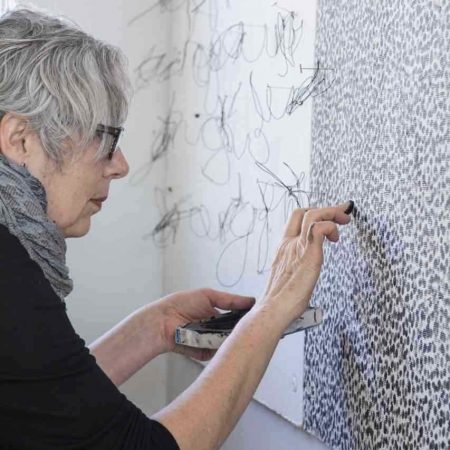You speak about stitching as a way to connect with a sensorial experience, often counting stitches as a way to ease anxiety about a task or “make sense” of something. Can you write about the power of the single stitch, and what it can represent in your work?
I don’t count each stitch but with each stitch, I am brought back to the present moment. As I stitch, the needle, the thread, the cloth is all consuming and I become more aware of their physical qualities, their beauty. For me, stitching and weaving are a form of tactile meditation and the labour involved liberates my mind and I can think clearly and access what I know.
Textile work can be very pattern-based; a weave is in a sense the architecture of the piece, a structure to build on. But your textile process is almost related to automatism, experimenting with automatic thoughts that arise from one stitch to the next, taking you in many directions. Can you comment on the conceptual side of your process, and the relationship of the mind to the hand?
In my approach to weaving and stitching I do improvise, I allow each row of weaving and every stitch to inform the next. It is very much like automatism – I find I am informed by the ritual of the experience, as well as the material and kinaesthetic process. When I weave and stitch I become so absorbed in the process that I am at one with the work, and informed and guided by it as I create. This opens up my imagination and leaves my mind free to explore and respond. When I create in this way I feel that I am grounded in the physical materials and that leaves my mind free to explore, imagine, observe and respond.
You were awarded a 2014 Governor General’s Award in Visual and Media Arts. In a video produced for this honour, you state that when you are sitting at your loom, you are “Witnessing to life, my life.” If there is a chronology to your process, what is the foundational link between your past work to your present work?
The foundational link between my past work to my present work is the improvisational and meditative nature of both.
What is a notebook keeper?
For me, a notebook keeper is someone who loves books-holding them; the left and right layout of them; the intimate scale of them; the tactility of them…AND someone who loves the way you can fill them, put them on a shelf, and begin another, and how they accumulate on your shelf; someone who loves the modesty of them; who loves that they are a kind of mobile studio; and someone who loves the daily ritual of sitting down in a quiet place, opening their notebook and responding there to whatever they are experiencing at that moment.
What is a tactile book?
A tactile book is one where the physical properties of the book are enhanced and played with and one in which the notebook keeper enjoys making words and images physical. In fact, the tactile approach guides the notebook keeper and enables them to think, reflect, and connect more fully and meaningfully on the page.
What’s next?
I have the feeling now that I want to return to my loom and weave with my eyes closed (literally)…to be guided by touch and my other senses as I weave and concentrate much more on the physicality of the medium. I think I am ready to experience making in a much more visceral way guided still by my belief in the power that comes from trusting that I will know what action to take as I go along.
